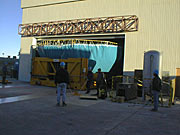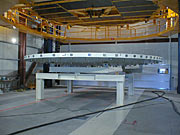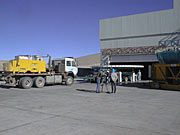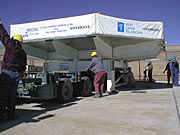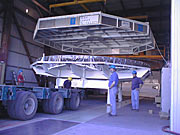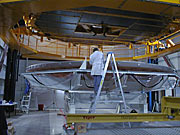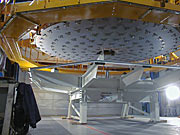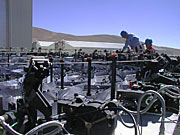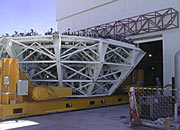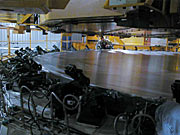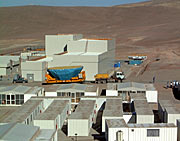Tisková zpráva
World's Largest Mirror Installed on First VLT Unit Telescope
17. dubna 1998
The world's largest optical mirror - with 8.2-m diameter and a surface of more than 50 m 2 , polished to the highest perfection - was today put in place at the First VLT Unit Telescope (UT1) at the Paranal Observatory.
If the present schedule is maintained and no significant technical problems occur, the first "scientific images" will be obtained with the UT1 during the night of May 25 - 26, 1998 (Chilean time). It would then be possible to present the first scientific images less than 24 hours later, in the morning of May 27, at Press Conferences in the ESO members countries and elsewhere that are part of the First Light Event.
The recent work at Paranal has included the first pointing tests of the UT1 , by means of the 20-cm telescope installed on the main structure. Already during the second night of these tests, the pointing error (RMS) was below 10 arcsec, an excellent value at this early stage. Continued improvements of the pointing software will bring this uncertainty further down to a few arcsec, and later to the design goal of 1 arcsec. This high precision will guarantee rapid and correct acquisition of the astronomical objects to be observed while saving precious observing time.
The main event during the past days was the exchange of the 8.2-m concrete dummy mirror with the "real" Zerodur mirror . This operation is documented in the present series of photos and starts with the removal of the M1 Cell with the concrete dummy from the lower end of the UT1.
The M1 cell was transported down the mountain to the Mirror Maintenance Building (MMB) at the Base Camp in the early morning on April 5. After some minor modifications to the Cell had been made, the concrete mirror was lifted up and the Cell was moved out of the building. Then, the concrete mirror was lowered upon its former support and placed near the box with the Zerodur mirror at the nearby storage area. It will be needed again during the coming weeks to test the installation of the Zerodur mirror in the coating unit, already installed in the MMB since last year.
On April 12, the box with the polished Zerodur mirror was placed below the Mirror Handling Device and the precious cargo was lifted off the supports on which it had been resting since it was ready at the REOSC factory in France. 150 interface cups which connect it to the M1 Cell were installed. Then the M1 Cell was placed directly below the mirror which was safely deposited on the computer-controlled supports that will give it the correct shape at the telescope. After further checking and under a protective cover, the M1 Cell with the 8.2-m Zerodur mirror was transported to the telescope and again attached to the bottom end. The mirror is still to be aluminized - this is planned in May.
Following the subsequent installation of the Beryllium secondary mirror (M2) at the top of the telescope tube, the fine optical alignment will start. This involves a careful optimization of the surface of the M1 Zerodur mirror by means of the active supports, and also the exact centering of the large M1 and M2 mirrors. Both are controlled by special software via the VLT Control System VCS). The utmost precision is necessary to guarantee that the sharpest possible images will be obtained in the excellent astroclimate at Paranal.
At the same time, other VCS software work continues to ensure that the heavy telescope can follow the diurnal motion of celestial objects with superior accuracy (optimization of the "pointing model").
Only when the engineers are satisfied that the UT1 is in perfect shape, optically, mechanically as well as electronically, will green light be given to open the shutter of the Test Camera at the Cassegrain focus for the first scientific exposures. That will mark the long-awaited moment of "First Light".
More information about the Very Large Telescope (VLT) project is available on the ESO Web.
O zprávě
| Tiskové zpráva č.: | eso9813 |
| Legacy ID: | Photo 10a-p/98 |
| Jméno: | Mirror, Very Large Telescope |
| Typ: | Unspecified : Technology : Observatory : Telescope |
| Facility: | Very Large Telescope |
Our use of Cookies
We use cookies that are essential for accessing our websites and using our services. We also use cookies to analyse, measure and improve our websites’ performance, to enable content sharing via social media and to display media content hosted on third-party platforms.
ESO Cookies Policy
The European Organisation for Astronomical Research in the Southern Hemisphere (ESO) is the pre-eminent intergovernmental science and technology organisation in astronomy. It carries out an ambitious programme focused on the design, construction and operation of powerful ground-based observing facilities for astronomy.
This Cookies Policy is intended to provide clarity by outlining the cookies used on the ESO public websites, their functions, the options you have for controlling them, and the ways you can contact us for additional details.
What are cookies?
Cookies are small pieces of data stored on your device by websites you visit. They serve various purposes, such as remembering login credentials and preferences and enhance your browsing experience.
Categories of cookies we use
Essential cookies (always active): These cookies are strictly necessary for the proper functioning of our website. Without these cookies, the website cannot operate correctly, and certain services, such as logging in or accessing secure areas, may not be available; because they are essential for the website’s operation, they cannot be disabled.
Functional Cookies: These cookies enhance your browsing experience by enabling additional features and personalization, such as remembering your preferences and settings. While not strictly necessary for the website to function, they improve usability and convenience; these cookies are only placed if you provide your consent.
Analytics cookies: These cookies collect information about how visitors interact with our website, such as which pages are visited most often and how users navigate the site. This data helps us improve website performance, optimize content, and enhance the user experience; these cookies are only placed if you provide your consent. We use the following analytics cookies.
Matomo Cookies:
This website uses Matomo (formerly Piwik), an open source software which enables the statistical analysis of website visits. Matomo uses cookies (text files) which are saved on your computer and which allow us to analyze how you use our website. The website user information generated by the cookies will only be saved on the servers of our IT Department. We use this information to analyze www.eso.org visits and to prepare reports on website activities. These data will not be disclosed to third parties.
On behalf of ESO, Matomo will use this information for the purpose of evaluating your use of the website, compiling reports on website activity and providing other services relating to website activity and internet usage.
Matomo cookies settings:
Additional Third-party cookies on ESO websites: some of our pages display content from external providers, e.g. YouTube.
Such third-party services are outside of ESO control and may, at any time, change their terms of service, use of cookies, etc.
YouTube: Some videos on the ESO website are embedded from ESO’s official YouTube channel. We have enabled YouTube’s privacy-enhanced mode, meaning that no cookies are set unless the user actively clicks on the video to play it. Additionally, in this mode, YouTube does not store any personally identifiable cookie data for embedded video playbacks. For more details, please refer to YouTube’s embedding videos information page.
Cookies can also be classified based on the following elements.
Regarding the domain, there are:
- First-party cookies, set by the website you are currently visiting. They are stored by the same domain that you are browsing and are used to enhance your experience on that site;
- Third-party cookies, set by a domain other than the one you are currently visiting.
As for their duration, cookies can be:
- Browser-session cookies, which are deleted when the user closes the browser;
- Stored cookies, which stay on the user's device for a predetermined period of time.
How to manage cookies
Cookie settings: You can modify your cookie choices for the ESO webpages at any time by clicking on the link Cookie settings at the bottom of any page.
In your browser: If you wish to delete cookies or instruct your browser to delete or block cookies by default, please visit the help pages of your browser:
Please be aware that if you delete or decline cookies, certain functionalities of our website may be not be available and your browsing experience may be affected.
You can set most browsers to prevent any cookies being placed on your device, but you may then have to manually adjust some preferences every time you visit a site/page. And some services and functionalities may not work properly at all (e.g. profile logging-in, shop check out).
Updates to the ESO Cookies Policy
The ESO Cookies Policy may be subject to future updates, which will be made available on this page.
Additional information
For any queries related to cookies, please contact: pdprATesoDOTorg.
As ESO public webpages are managed by our Department of Communication, your questions will be dealt with the support of the said Department.


